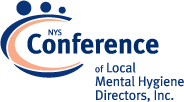NYS Conference of Local Mental Hygiene Directors, Inc. | An Affiliate of the New York State Association of Counties >
Hot Topics / Priority Issues
Pew Charitable Trust: How States Address Opioid Use Disorder in Prisons

Individuals within the criminal justice system have a high prevalence of substance use disorder (SUD), including opioid use disorder (OUD). Based on the latest data from the Bureau of Justice Statistics, from 2007 to 2009 an estimated 58 percent of state prisoners and 63 percent of sentenced jail inmates met criteria for SUD (defined as drug dependence or abuse by the Diagnostic and Statistical Manual of Mental Disorders). These figures exclude those with nicotine and alcohol use disorders.
In prisons and jails, people with OUD have limited access to medication-assisted treatment (MAT), which combines medications approved by the Food and Drug Administration with behavioral therapies and is considered the gold standard of care. In addition, formerly incarcerated individuals have a 12.2-fold increased risk of fatal drug overdose compared with the general public. Accordingly, improving access to MAT during incarceration can help prevent nonfatal overdoses and deaths, and support engagement with treatment after release.
At the Council for State Governments’ national conference in December, The Pew Charitable Trusts hosted a session that brought together policymakers from across the country to share approaches for addressing the treatment needs of the criminal justice population and increasing their access to MAT. Officials discussed how states are working to expand access to lifesaving care for individuals within correctional facilities and those re-entering their communities. The conversation focused specifically on financing for MAT and how states have leveraged Medicaid funding to increase access to this treatment.
State approaches for MAT within corrections
In Colorado, Denver Health Medical Center, one of the state’s largest safety-net hospitals—which provides care regardless of a patient’s insurance status—partnered with Denver’s city and county jails to increase access to MAT. As a result, all three forms of FDA-approved medication for OUD (methadone, buprenorphine, and naltrexone) are now available in these facilities. MAT induction—when treatment begins—and maintenance services, as well as wraparound social services like case management, are also available as individuals re-enter the community. The MAT program is funded in part by revenue from a tax on marijuana enacted in 2015 (H.B. 15-1367), state general funds, and a State Targeted Response to the Opioid Crisis (STR) federal grant.
Lawmakers in Kentucky have sought to combat high rates of SUD in their correctional institutions via the 2015 law S.B. 192. The bill increased funding for naltrexone and SUD treatment programs, such as the Substance Abuse Medication Assisted Treatment program, with the goal of decreasing drug overdoses and increasing and improving SUD treatment post-release. According to the 2017 “Criminal Justice Kentucky Treatment Outcome Study” report, participants in the SUD program reported that the structured environment, mentorship offerings, and sense of community all supported their recovery.
In 2015, Pennsylvania lawmakers passed Act 80, establishing the Nonnarcotic Medication Assisted Substance Abuse Treatment Grant Pilot Program to minimize relapse and prevent overdose fatalities within the state Department of Corrections (DOC). Using state funds, the program allocated $1.5 million in SUD treatment grants to county correctional facilities to provide naltrexone to inmates at release. This law also allowed the state to utilize State Opioid Response (SOR) federal grants to fund prison-based social workers, who connect inmates to naltrexone and help coordinate their care upon release. The DOC continues to expand access to OUD treatment medication through a 2019 pilot program for buprenorphine.
Facilitating access to SUD care post-release
Prior to the Affordable Care Act, as many as 70 percent of those leaving prison and 90 percent leaving jails lacked health care coverage, making it difficult to connect them with behavioral health services. While many states have improved access to SUD treatment for these people through expansion of Medicaid, other states have implemented community-based approaches to support access.
Ohio modified its Medicaid managed-care contracts to provide care coordination for individuals identified as high-need and arrange community-based services before release from the criminal justice system. Ohio also uses STR funds for counties to improve and expand its SUD workforce treatment capacity. By using these funds to increase the number of physicians with buprenorphine waivers, which allow them to prescribe the medication, the state has been able to increase treatment availability and access.
Virginia’s Addiction and Recovery Treatment Services (ARTS) program also helped expand the SUD workforce and community-based treatment. ARTS expanded Medicaid benefits, giving recipients greater access to SUD treatment across a continuum of care, including residential and community-based treatment. After the program was implemented in 2017, the state saw a 34 percent increase in the number of providers with buprenorphine waivers and a 64 percent increase in Medicaid beneficiaries receiving SUD treatment.
Sharing state approaches
States and local communities are successfully funding efforts that improve the availability and effectiveness of SUD and OUD treatment for individuals in the justice system. By utilizing MAT and improving access to this lifesaving treatment, communities and correctional agencies can reduce the risk of overdose and death post-release.



